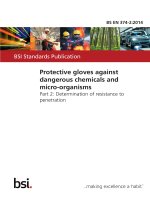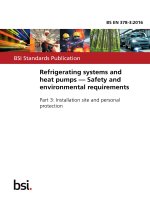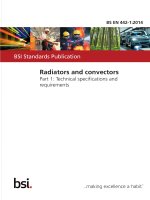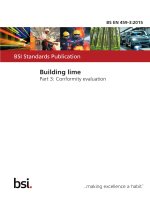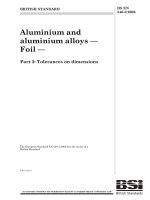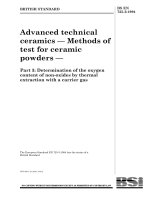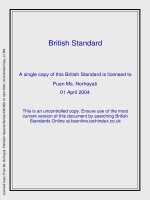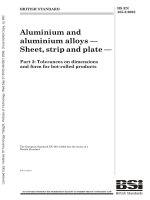Bsi bs en 12814 3 2014
Bạn đang xem bản rút gọn của tài liệu. Xem và tải ngay bản đầy đủ của tài liệu tại đây (1.27 MB, 30 trang )
BS EN 12814-3:2014
BSI Standards Publication
Testing of welded joints in
thermoplastics semi-finished
products
Part 3: Tensile creep test
BS EN 12814-3:2014
BRITISH STANDARD
National foreword
This British Standard is the UK implementation of EN 12814-3:2014.
It supersedes BS EN 12814-3:2000 which is withdrawn.
The UK participation in its preparation was entrusted to Technical
Committee PRI/80, Welding thermoplastics.
A list of organizations represented on this committee can be
obtained on request to its secretary.
This publication does not purport to include all the necessary
provisions of a contract. Users are responsible for its correct
application.
© The British Standards Institution 2014. Published by BSI Standards
Limited 2014
ISBN 978 0 580 78955 7
ICS 25.160.40
Compliance with a British Standard cannot confer immunity from
legal obligations.
This British Standard was published under the authority of the
Standards Policy and Strategy Committee on 28 February 2014.
Amendments issued since publication
Date
Text affected
BS EN 12814-3:2014
EN 12814-3
EUROPEAN STANDARD
NORME EUROPÉENNE
EUROPÄISCHE NORM
February 2014
ICS 25.160.40
Supersedes EN 12814-3:2000
English Version
Testing of welded joints in thermoplastics semi-finished products
- Part 3: Tensile creep test
Essais des assemblages soudés sur produits semi-finis en
thermoplastiques - Partie 3: Essai de fluage en traction
Prüfen von Schweißverbindungen aus thermoplastischen
Kunststoffen - Teil 3: Zeitstand-Zugversuch
This European Standard was approved by CEN on 30 November 2013.
CEN members are bound to comply with the CEN/CENELEC Internal Regulations which stipulate the conditions for giving this European
Standard the status of a national standard without any alteration. Up-to-date lists and bibliographical references concerning such national
standards may be obtained on application to the CEN-CENELEC Management Centre or to any CEN member.
This European Standard exists in three official versions (English, French, German). A version in any other language made by translation
under the responsibility of a CEN member into its own language and notified to the CEN-CENELEC Management Centre has the same
status as the official versions.
CEN members are the national standards bodies of Austria, Belgium, Bulgaria, Croatia, Cyprus, Czech Republic, Denmark, Estonia,
Finland, Former Yugoslav Republic of Macedonia, France, Germany, Greece, Hungary, Iceland, Ireland, Italy, Latvia, Lithuania,
Luxembourg, Malta, Netherlands, Norway, Poland, Portugal, Romania, Slovakia, Slovenia, Spain, Sweden, Switzerland, Turkey and United
Kingdom.
EUROPEAN COMMITTEE FOR STANDARDIZATION
COMITÉ EUROPÉEN DE NORMALISATION
EUROPÄISCHES KOMITEE FÜR NORMUNG
CEN-CENELEC Management Centre: Avenue Marnix 17, B-1000 Brussels
© 2014 CEN
All rights of exploitation in any form and by any means reserved
worldwide for CEN national Members.
Ref. No. EN 12814-3:2014 E
BS
12814-3:2014
ENEN
12814-3:2014
(E)
Contents
Page
Foreword ..............................................................................................................................................................3
Introduction .........................................................................................................................................................4
1
Scope ......................................................................................................................................................5
2
Normative references ............................................................................................................................5
3
Terms and definitions ...........................................................................................................................5
4
Symbols and designations ...................................................................................................................5
5
Principle of the test................................................................................................................................6
6
Sampling procedures ............................................................................................................................7
7
Dimensions of test specimens .............................................................................................................7
8
Cutting and preparation of test specimens ........................................................................................9
9
Mechanical testing .............................................................................................................................. 10
10
Test equipment ................................................................................................................................... 10
11
Determination of the long-term welding factor ................................................................................ 11
12
Test report ........................................................................................................................................... 13
Annex A (informative) Resistance to slow crack growth ............................................................................. 15
Annex B (informative) Whole pipe tensile creep rupture test ...................................................................... 18
Annex C (informative) Minimum creep rupture time of the parent material (ttm) for applicability of
the long-term welding factor ............................................................................................................. 21
Annex D (informative) Testing of socket joints ............................................................................................. 22
Bibliography ..................................................................................................................................................... 25
2
BS EN
12814-3:2014
EN
12814-3:2014
(E)
Foreword
This document (EN 12814-3:2014) has been prepared by Technical Committee CEN/TC 249 “Plastics”, the
secretariat of which is held by NBN.
This European Standard shall be given the status of a national standard, either by publication of an identical
text or by endorsement, at the latest by August 2014, and conflicting national standards shall be withdrawn at
the latest by August 2014.
Attention is drawn to the possibility that some of the elements of this document may be the subject of patent
rights. CEN [and/or CENELEC] shall not be held responsible for identifying any or all such patent rights.
This document supersedes EN 12814-3:2000.
The main changes with respect to the previous edition are listed below:
a)
addition of a NOTE for an alternative test using a whole pipe welded sample (Clause 5) making reference
to Annex B (informative), Whole pipe tensile creep rupture test;
b)
addition of a NOTE for the sampling procedures (Clause 6) in case of socket joints with reference to
Annex D (informative), Testing of socket joints.
EN 12814, Testing of welded joints of thermoplastics semi-finished products, is divided into the following
parts:
—
Part 1: Bend test;
—
Part 2: Tensile test;
—
Part 3: Tensile creep test (the present document);
—
Part 4: Peel test;
—
Part 5: Macroscopic examination;
—
Part 6: Low temperature tensile test;
—
Part 7: Tensile test with waisted test specimens;
—
Part 8: Requirements.
According to the CEN-CENELEC Internal Regulations, the national standards organizations of the following
countries are bound to implement this European Standard: Austria, Belgium, Bulgaria, Croatia, Cyprus, Czech
Republic, Denmark, Estonia, Finland, Former Yugoslav Republic of Macedonia, France, Germany, Greece,
Hungary, Iceland, Ireland, Italy, Latvia, Lithuania, Luxembourg, Malta, Netherlands, Norway, Poland, Portugal,
Romania, Slovakia, Slovenia, Spain, Sweden, Switzerland, Turkey and the United Kingdom.
3
BS
12814-3:2014
ENEN
12814-3:2014
(E)
Introduction
The design of welded thermoplastics constructions under static load is based on the long-term creep rupture
with behaviour, specifically the resistance to slow crack growth of the thermoplastics material and the welds.
For design purposes, the relevant characteristic values for the welded joints are the “long-term tensile welding
factors” to which this European Standard provides the test method.
The long-term tensile welding factors are normally used in conjunction with the creep rupture curve of the
parent material, given for example in EN 1778, when designing welded semi-finished products under static
load.
The long-term tensile welding factor(s), the crack behaviour and the appearance of the fracture surface
provide information on the quality of the weld.
NOTE
The behaviour of the failure obtained during the tensile creep test can be related to the notch sensitivity of the
parent material. An example of a test to provide information about the notch sensitivity of parent material is given in
Annex A.
4
BS EN
12814-3:2014
EN
12814-3:2014
(E)
1
Scope
This European Standard specifies the dimensions, the method of sampling and the preparation of the test
specimens, and the conditions for performing the tensile creep test perpendicular to the weld in order to
determine the long-term tensile welding factor.
A tensile creep test may be used in conjunction with other tests (e.g. bend test, tensile test, macrographic
examination, …) to assess the performance of welded assemblies, made from thermoplastics materials.
The test is applicable to welded assemblies made from thermoplastics materials filled or unfilled such as tubes
and fittings, sheets, plates and profiles, but not reinforced, irrespective of the welding process used.
2
Normative references
The following documents, in whole or in part, are normatively referenced in this document and are
indispensable for its application. For dated references, only the edition cited applies. For undated references,
the latest edition of the referenced document (including any amendments) applies.
EN 13100-1, Non destructive testing of welded joints of thermoplastics semi-finished products — Part 1:
Visual examination
EN ISO 899-1, Plastics — Determination of creep behaviour — Part 1: Tensile creep (ISO 899-1)
3
Terms and definitions
For the purposes of this document, the following terms and definitions apply.
3.1
test temperature
temperature of the medium surrounding the test specimen during the test
3.2
test stress
test load divided by the minimum cross sectional area of the test specimen
3.3
creep rupture curve
regression curve through the geometric mean values of failure times
3.4
minimum failure time
ttm
creep rupture time of the parent material to ensure that the test method is applicable
3.5
ductile fracture
large scale deformation of material from fracture surfaces
3.6
brittle fracture
little or no deformation of material from fracture surfaces
4
Symbols and designations
Symbols and designations are given in Table 1.
5
BS
12814-3:2014
ENEN
12814-3:2014
(E)
Table 1 — Symbols and designations
Designations
Symbols
a
Minimum measured thickness of test specimen within calibrated
and parallel length
mm
an
Nominal thickness of test piece
mm
b
Width of calibrated and parallel length of the test specimen
mm
b1
Width of shoulder of the test specimen
mm
c
Depth of the notch
mm
Nominal outside diameter of the tube
mm
Dn
fl
Long-term tensile welding factor
Fs
Value of the force applied to the welded test specimen calculated
from the chosen value of σs
N
Ft
Value of the force applied to the unwelded test specimen
calculated from the chosen value of σt
N
L
Total length of the test specimen
mm
Lj
Minimum distance between the clamping jaws
mm
L0
Calibrated and parallel length of the test specimen
mm
Maximum width of the weld bead of the test specimen
mm
Radius of shoulder of the test specimen
mm
Lw
a
r
a
5
Units
ttm
Minimum failure time
σs
Value of stress of the welded test specimens used in the
calculation of fl
N/mm
2
σt
Reference stress. Value of stress of the unwelded test
specimens, used in the calculation of fl
N/mm
2
h
For extrusion and hot gas welds only.
Principle of the test
The test involves subjecting a test specimen to a constant load until fracture occurs. The time to fracture is
measured and recorded.
NOTE
Annex B.
6
An alternative test using a whole pipe welded sample rather that a test specimen cut form the weld is given in
BS EN
12814-3:2014
EN
12814-3:2014
(E)
The tests are carried out over a range of temperatures and loads, and in a test medium. Only such media
shall be used which cause no swelling or degradation of the polymer. Examples of available test media are
air, water or solutions of demineralised water with detergents.
Care should be taken to ensure that the condition of the test medium does not influence the results of the test.
The applicability of the long-term tensile welding factor for design purposes requires a minimum creep rupture
time for the parent material (ttm). Before determining the long-term welding factor for the materials mentioned
in Annex C, a tensile creep test should be carried out on the parent material at one of the test conditions given
in Table C.1. The values of creep rupture time should be at least that quoted in Table C.1.
Application standards may prescribe higher values for these rupture times depending upon the semi-finished
product and material.
6
Sampling procedures
Welded and unwelded test specimens shall be taken from the same test piece.
NOTE
In the case of socket joints, see Annex D.
The test specimens (welded and unwelded) shall be cut perpendicular to the welded joint at least eight hours
after welding. For sheets where the extrusion direction is different on either side of the weld, the unwelded test
specimens shall be taken from the side of the test piece which has the lowest creep rupture time.
Each test specimen shall be marked in order to identify its original position within the test piece.
No heat treatment or mechanical straightening operations shall be carried out on the test specimen.
7
Dimensions of test specimens
The dimensions of test specimens according to Figure 1 are given in Table 2 and those according to Figure 2
are given in Table 3.
Profiles can be tested if test specimens are in accordance with the dimensions given in Table 2 or Table 3.
For tubes having nominal outside diameter less than 20 mm, the whole tube shall be tested. In this case, the
minimum distance between the clamps shall be 200 mm.
7
BS
12814-3:2014
ENEN
12814-3:2014
(E)
Key
Lj
= L0 + (2xb)
Figure 1 — Type 1 test specimen for flat and tubular assemblies
Figure 2 — Type 2 test specimen for flat and tubular assemblies
8
BS EN
12814-3:2014
EN
12814-3:2014
(E)
Table 2 — Dimensions of type 1 test specimens
Dimensions in millimetres
Dn or an
b
L0
L
20 ≤ Dn < 50
an +
Dn
10
80
≥ 120
50 ≤ Dn < 100
an +
Dn
10
120
≥ 170
Dn ≥ 100 or
flat assemblies:
an ≤ 10
15
120
≥ 170
10 < an ≤ 20
30
120
≥ 170
an > 20
1,5 x an
3 x an + Lw
with 120 min
≥ L0 + 80
Table 3 — Dimensions of type 2 test specimens
Dimensions in millimetres
Dn or an
b
min. b1
L0
L
r
20 ≤ Dn < 50
an +
Dn
10
b + 10
Lw + 60
≥ 120
60
50 ≤ Dn < 100
an +
Dn
10
b + 10
Lw + 60
≥ 170
60
Dn ≥ 100 or
flat assemblies:
an ≤ 10
10
20
115
≥ 170
60
10 < an ≤ 20
30
40
115
≥ 170
60
an > 20
1,5 x an
2,5 x an
3 x an + L w
with 120 min
≥ L0 + 80
60
Where the beads are left intact in service, they shall be left intact for the test. Where the beads are removed in
service, they shall be removed prior to testing.
The minimum value for b shall be 6 mm. The tolerance for b shall be ± 1 mm. The tolerance for L0 shall
be ± 2 mm.
The variation of b over the length L0 shall not exceed ± 2 % of the average value of b.
8
Cutting and preparation of test specimens
The tensile creep test specimens shall be cut with parallel sides as shown in Figures 1 and 2. During cutting,
heating of the test specimen shall be minimized.
The cutting operation shall not cause any damage to the test specimen.
After cutting, a visual examination of the weld according to EN 13100-1 shall be carried out and recorded.
9
BS
12814-3:2014
ENEN
12814-3:2014
(E)
9
Mechanical testing
The stress is applied to the test specimen at constant temperature, static tensile load and constant ambient
conditions.
Test specimens shall be conditioned to the test temperature before loading. The variation of the test
temperature shall not exceed ± 1 °C.
For every stress level and every test temperature, a minimum number of six welded test specimens and six
unwelded test specimens shall be tested. The test shall be carried out according to EN ISO 899-1.
The test conditions shall be chosen in such a way that at least 30 % of the fracture area has undergone brittle
failure, as described in Figure 3.
To shorten the duration of the test, it is possible to use an appropriate aqueous surfactant solution as the
contact medium for both welded and unwelded test specimens.
The test specimens shall be progressively subjected to the test load. The duration of the test shall be taken
from the moment of reaching test load until the test specimen fractures.
Key
1
area of crack surface that has undergone brittle fracture
2
area of crack surface that has undergone ductile fracture
Figure 3 — Characteristics of fracture surface
The fracture behaviour of welded joints, where fracture occurs in the parent material and is initiated from notch
between the parent material and the weld bead (see Figure 3), is closely related to the resistance to slow
crack growth of the parent material.
The resistance to slow crack growth of the parent material can be determined using the Full Notch Creep Test
(see Annex A).
10 Test equipment
Figure 4 shows an example of the test equipment for the tensile creep test.
10
BS EN
12814-3:2014
EN
12814-3:2014
(E)
Key
1
test medium tank
2
test specimen (with weld bead)
3
test environment
4
dead weight
Figure 4 — Example of test equipment for long-term tensile creep tests
11 Determination of the long-term welding factor
To determine the slope of the creep rupture curve in a bi-logarithmic scale, tests shall be carried out at a
minimum of two stress levels.
In order to determine the long-term tensile welding factor, the creep rupture curves of the welded and
unwelded test specimens shall be established. The regression curves shall be calculated from the geometric
mean of the single values, i.e.:
log mean = [log t1 + log t2 + ... log tn] / n
11
BS
12814-3:2014
ENEN
12814-3:2014
(E)
From these curves, as shown in Figure 5, the long-term tensile welding factor shall be calculated as the ratio
of the stress value of the weld (σS) and of the parent material (σt) at identical failure times.
fl =
σs
σt
where
σs =
Fs
and
ab
σt =
Ft
.
ab
Key
1
log stress
2
log time to failure
3
curve for parent material
4
reference stress
5
curve for welded joint
Figure 5 — Example of creep rupture curves
A constant long-term tensile welding factor over the whole range of times will result only if the curves run
parallel.
When the curves are not parallel, the long-term tensile welding factor shall be calculated at a reference stress
for parent material agreed between the contracting parties.
No test specimen shall be disregarded unless failure occurs in the clamps.
Failures within a distance of 1 times thickness (an) from the clamps shall not be used in the evaluation of the
test results.
In the case of the type 1 test specimens, failure within a distance of 1 times test specimen width (b) from the
clamps shall be regarded as failure in the clamp.
If type 1 test specimens consistently fail in the clamps then type 2 test specimens shall be used.
In the case of type 2 test specimens, failure outside of the calibrated length (L0), shall be regarded as failure in
the clamp.
12
BS EN
12814-3:2014
EN
12814-3:2014
(E)
In the case of the whole tube tensile creep test, failure within a distance of 1,5 Dn from the clamps shall be
regarded as failure in the clamp.
Providing a long-term welding factor and reference stress, a simplified method, but without information about
the slopes of the creep curves can be used by testing the parent material at σt and welded material at σt
multiplied by the required long-term welding factor. The creep rupture time of the welded test specimen shall
at least be equal to that of the parent material.
12 Test report
The test report shall refer to this European Standard and it shall include at least the following information:
a)
description and identification of the test piece and test specimens;
b)
appearance of the test pieces before the test:
1)
visual examination of welding work;
2)
beads removed or not;
c)
weld type;
d)
maximum width of the weld bead, if applicable;
e)
nominal outside diameter of the tube, if applicable;
f)
number of test specimens;
g)
type of test specimen;
h)
appearance of all surfaces of the test specimens (e.g. flaws, scratches, visual imperfections);
i)
thickness of test specimen;
j)
width of calibrated and parallel length;
k)
calibrated and parallel length (L0);
l)
total length of the test specimen;
m) width of test specimen shoulder, if applicable;
n)
radius of shoulder;
o)
distance between the clamping jaws;
p)
test temperature;
q)
test medium;
r)
test force or stress;
s)
visual examination of the ruptured surface;
t)
percentage of brittle area of the crack surface (whether greater or less than 30 %);
u)
time to fracture of test specimen;
v)
elongation of test specimens after the test, if required;
13
BS
12814-3:2014
ENEN
12814-3:2014
(E)
w) calculated value of the long-term tensile welding factor (fl) with information about the reference stress of
the parent material;
x)
identification of the laboratory;
y)
date of the test;
z)
name and signature of the responsible person for the test report.
14
BS EN
12814-3:2014
EN
12814-3:2014
(E)
Annex A
(informative)
Resistance to slow crack growth
A.1 Full notch creep test (FNCT)
A.1.1 Principle
The resistance to slow crack growth of the parent material can be determined using the Full Notch Creep
Test.
The applied stress chosen should be such that it induces a brittle fracture surface. Values for test stress and
test temperature are given in Table C.1. For thermoplastics, lower temperatures will increase the time to
failure of the test piece.
A.1.2 Preparation of the test specimens
The test specimens for the FNCT shall be cut from the parent material perpendicular to the welded joint from
the same test piece used for the tensile creep test.
The test specimens for the FNCT shall be cut with parallel sides as shown in Figure A.1. The minimum
distance between the clamps and the notch shall be 2 x an.
A.1.3 Test specimen notching
The test specimen shall be notched on all four sides in the same plane. The depth of the notch, c, shall be
17 % ± 2 % of the measured thickness, a. A notch is produced by pressing a razor blade or a similar tool,
which gives an identical result, into the test specimen. It is important to make all the notches coplanar. Test
specimens shall be notched at a room temperature of 23 °C ± 2 °C.
To ensure consistency of results, the razor blade shall be periodically changed.
A.1.4 Mounting and conditioning
The test specimen shall be loaded free from external torsion and bendings effects. The whole test specimen
shall be immersed in the test medium.
The test specimen shall be conditioned to the test temperature before loading.
A.1.5 Calculation of the test load (Ft)
Ft = A x σ
where
Ft
is the test load (N);
A
is the ligament area of the test specimen after notching (mm );
σ
is the tensile stress according to Table C.1 (N/mm ).
2
2
15
BS
12814-3:2014
ENEN
12814-3:2014
(E)
Key
1
clamp
2
notch
a
measured thickness of test specimen
b
width of test specimen
c
depth of the notch, where 0,95 x a ≤ b ≤ 1,05 x a
Figure A.1 — FNCT test specimen
A.2 Two notch creep test (2NCT)
A.2.1 Principle
The resistance to slow crack growth of parent material with a wall thickness of less than 10 mm can be
determined using the Two Notch Creep Test.
The applied stress chosen should be such that it induces a brittle fracture surface. The minimum thickness of
the test specimens should be 3,0 mm. Values for test stress and test temperature are given in Table C.1. For
thermoplastics, lower temperatures will increase the time to failure of the test piece.
A.2.2 Preparation of the test specimens
The test specimens for the 2NCT shall be cut from the parent material perpendicular to the welded joint from
the same test piece used for the tensile creep test.
The test specimens for the 2NCT shall be cut with parallel sides as shown in Figure A.2. The minimum
distance between the clamps and the notch shall be 2 x an.
A.2.3 Test specimen notching
The test specimen shall be notched on two sides in the same plane. The depth of the notch, c, shall be
17 % ± 2 % of the measured width, b. A notch is produced by pressing a razor blade or a similar tool, which
gives an identical result, into the test specimen. It is important to make both notches coplanar. Test specimens
shall be notched at a room temperature of 23 °C ± 2 °C.
To ensure consistency of results, the razor blade shall be periodically changed.
16
BS EN
12814-3:2014
EN
12814-3:2014
(E)
A.2.4 Mounting and conditioning
The test specimen shall be loaded free from external torsion and bendings effects. The whole test specimen
shall be immersed in the test medium.
The test specimen shall be conditioned to the test temperature before loading.
A.2.5 Calculation of the test load (Ft)
Ft = A x σ
where
Ft
is the test load (N);
A
is the ligament area of the test specimen after notching (mm );
σ
is the tensile stress according to Table C.1 (N/mm );
2
2
Key
1
load
2
notch
3
sheet:
a
measured thickness of test specimen
b
width of test specimen
c
depth of the notch with a ≥ 1,7 mm
4
pipe
Figure A.2 — 2NCT test specimen
17
BS
12814-3:2014
ENEN
12814-3:2014
(E)
Annex B
(informative)
Whole pipe tensile creep rupture test
B.1 General
This test is applicable to welded pipe assemblies made from thermoplastics materials, irrespective of the
welding process used. It has the advantage that it tests the whole welded joint. The test results can be used
for comparative purposes and can be used to optimise the welding process.
B.2 Principle
The test involves subjecting a welded length of pipe to a constant load at a constant elevated temperature
until fracture occurs. The time to fracture is measured and recorded.
B.3 Mounting and conditioning
The test sample shall be loaded free from external torsion and bending. The whole sample between the end
fittings shall be immersed in the test medium. The test sample shall be conditioned to the test temperature
before loading.
B.4 Mechanical testing
Figure B.1 shows an example of the test equipment for the whole pipe tensile creep rupture test.
18
BS EN
12814-3:2014
EN
12814-3:2014
(E)
Key
1
hydraulic jack
2
supporting plate
3
water line
4
top end fitting
5
push rod
6
weld
7
pipe test sample
8
bottom end fitting
Figure B.1 — Example of test equipment for whole pipe tensile creep rupture tests
The test conditions shall be chosen such that at least 30 % of the wall thickness at the location of the failure
has undergone brittle fracture, as shown in Figure B.2.
19
BS
12814-3:2014
ENEN
12814-3:2014
(E)
Figure B.2 — Typical fracture surface at the location of failure
B.5 Evaluation
In order to evaluate the test results, the geometric mean value shall be calculated from the individual rupture
times. This value shall be used for comparative purposes only. The determination of the long-term tensile
welding factor is not required.
B.6 Test report
The test report shall be as defined in Clause 12, except for the calculated value of the long-term tensile
welding factor (fl).
20
BS EN
12814-3:2014
EN
12814-3:2014
(E)
Annex C
(informative)
Minimum creep rupture time of the parent material (ttm)
for applicability of the long-term welding factor
Table C.1 — ttm values for some thermoplastics materials
a
a
Material
Stress
MPa
Temperature
°C
ttm
h
PP-H
4
95
400
PP-H
3,5
95
600
PE
4
80
500
These values were determined in a test medium of demineralised water containing 2 % of nonyl-phenoxy
(ethyleneoxy) ethanol with 10 ethyleneoxide molecules.
21
BS
12814-3:2014
ENEN
12814-3:2014
(E)
Annex D
(informative)
Testing of socket joints
D.1 General
This test is valid for heated tool socket and electrofusion fittings welded to pipes with a minimum wall
thickness of 8 mm. The test results can be used for comparative purposes and can be used to optimise,
e.g. the welding process or the construction of the fitting. The comparison between electrofusion and heated
tool socket fitting systems is not possible without additional analysis.
D.2 Sampling procedure
The test specimens shall be cut perpendicular to the welded joint at least eight hours after welding. At least six
pre-test specimens shall be cut from each side of the welded joint, except for electrofusion fittings that have
had both sides welded simultaneously, where three specimens from each side are sufficient. However, if the
results are significantly different between the two sides, the number of test specimens shall be increased to
six per side.
D.3 Dimensions of test specimens
The dimensions of the pre-test specimens are given in Figure D.1.
Dimensions in millimetres
Figure D.1 — Dimensions of pre-test specimen
The dimensions of the final test specimen are given in Figure D.2.
22
BS EN
12814-3:2014
EN
12814-3:2014
(E)
Dimensions in millimetres
Key
1
pre-test specimen
d
= 16 mm
L0
≥ 2d
Figure D.2 — Dimensions of final test specimen
D.4 Cutting and preparation of test specimens
Pre-test specimens shall be cut from the welded joint using, for example, a hole-driller. The specimens shall
be taken from the middle of the fusion length, as shown in Figure D.3.
a) heated tool socket weld
b) electrofusion weld
Figure D.3 — Position of the pre-test specimen in the welded joint for
Pre-test specimens cut from electrofusion joints shall contain at least three wires and shall contain no voids.
In order to produce the final test specimen, extension bars shall be welded (using, for example, heated tool
butt welding) to the pre-test specimen, as shown in Figure D.4. The surfaces of the pre-test specimens shall
be machined flat prior to welding.
23
